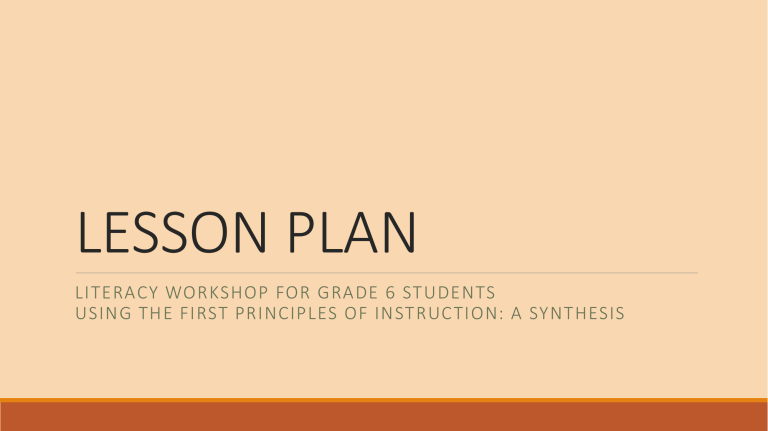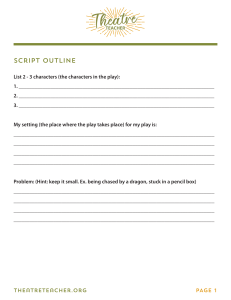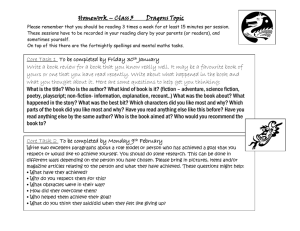
LESSON PLAN LITERACY WORKSHOP FOR GRADE 6 STUDENTS USING THE FIRST PRINCIPLES OF INSTRUCTION: A SYNTHESIS Enabling Objective Distinguish the parts of a story: Title, Subtitle and Captions the same author. Objective After participating in an instructional literacy camp which is part of the literacy programme, the learners will be able to: prepare a story with its essential parts such as title, subtitle and cation the author; use the part of a story to extrapolate information from a story/passage. Level 2: Interpretation (Application) Rationale The rationale for using instructional strategies – Merrill’s first Principles of Instruction is it is generalizable and very appropriate for this course of study. It identifies the basic components of instruction. For each objective, he argues that instruction needs to: Activate prior knowledge about the topic. Demonstrate the performance. Application – Provide practice. Integration Merrill's First Principles of Instruction Integration Activation Problem / Task Application Demonstration Activate Prior Knowledge Learning is promoted when learners activate relevant cognitive structures by being directed to recall, describe or demonstrate relevant prior knowledge or experience. Students will be given a printed semantic map each. They will be asked to brainstorm and write their ideas on the map about a story. STORY Demonstrate Students will read the information provide by the sites below: https://www.3playmedia.com/blog/captions-vs-subtitles-do-you-know-the-difference/ https://www.thoughtco.com/text-features-in-non-fiction-3111227 Learners will become involved in a collaborative discussion that will require them to distinguish the parts of a story has seen on the sites and in the videos. Demonstrate Students will watch the following video which shows various examples of text features: https://learnzillion.com/lesson_plans/6559-locate-information-using-text-features/ Application / apply Application is effective only when learners receive intrinsic or corrective feedback. Therefore, throughout this stage, learners will be provided with corrective feedback. PRACTICE PASSAGES: PASSAGE1: The Woodstock Music and Art Fair—better known to its participants and to history simply as “Woodstock”—should have been a colossal failure. Just a month prior to its August 15, 1969 opening, the fair’s organizers were informed by the council of Wallkill, New York, that permission to hold the festival was withdrawn. Amazingly not only was a new site found, but word spread to the public of the fair’s new location. At the new site, fences that were supposed to facilitate ticket collection never materialized, and all attempts at gathering tickets were abandoned. Crowd estimates of 30,000 kept rising; by the end of the three days, some estimated the crowd at 500,000. Then, on opening night, it began to rain. Off and on, throughout all three days, huge summer storms rolled over the gathering. In spite of these problems, most people think of Woodstock not only as a fond memory but as the defining moment for an entire generation. Which of the following would be the most appropriate title for this passage? a. Backstage at Woodstock b. Woodstock: From The Band to The Who c. Remembering Woodstock d. Woodstock: The Untold Story Application / apply Application is effective only when learners receive intrinsic or corrective feedback. Therefore, throughout this stage, learners will be provided with corrective feedback. PASSAGE2: Use of electronic mail (e-mail) has been widespread for more than a decade. E-mail simplifies the flow of ideas, connects people from distant offices, eliminates the need for meetings, and often boosts productivity. However, e-mail should be carefully managed to avoid unclear and inappropriate communication. E-mail messages should be concise and limited to one topic. When complex issues need to be addressed, phone calls are still best. Which of the following would be the most appropriate title for the passage? a. Appropriate Use of E-Mail b. E-Mail’s Popularity c. E-Mail: The Ideal Form of Communication d. Why Phone Calls Are Better Than E-Mail Application / apply Mobile Phones by starlightdreamerz 1. How could you use the title or headings of the passage to predict the main idea? She wakes up. The first thing she does is search for her cell phone in her bed. Yesterday evening she slept with her cell phone in her hand. She couldn’t find her cell phone but she wants to check for new messages. Desperately she continues searching for her cell phone. She makes the whole bed a mess just to search for her cell phone. After taking the sheets off from the bed in search for her cell phone, she gives up. She puts back all the sheets she took off from the bed while searching for her cell phone. Where is her cell phone? 2. In what other situations would bold letters be useful? 3. Who is the author? 4. What text features would you include if you were writing an article on basketball? 5. Write an appropriate subtitle for this paragraph. Integration Integration is enhanced when learners create, invent, or explore personal ways to use their new knowledge or skill. Students will apply the new knowledge during instruction by completing the activity below. Find three different nonfiction books. Scan each work and observe the formatting choices made by the author and publishing team. In particular, take a look at titles, headings, and subheadings. Are they formatted differently? Are they indented? Is the font a different size, color, or case (lower/upper)? Are they bold or underlined? What else do you notice? Title of Book Formatting Observations Look back at the information you collected, comparing all three texts. What is similar? What is different? Did you find any instances of formatting that you had never noticed before? Integration Someone mixed up all of the sentences of this piece of writing! Cut the strips apart and then put them in an order that makes sense to you. When you’re done, write the piece in the order you’ve chosen on a separate paper. Make sure to indent at the beginning of paragraphs and insert the title, headings, and subheadings before each section. Open just the lid of the dragon carrier and let it get settled before releasing it into your Dragons are not easy to train and can, in fact, be very dangerous. home. Bringing Your Dragon Home Then, carefully remove it from the carrier and just allow it to look at you. You will also need treats to reward the desired behavior when (and if) it follows Be sure to put your dragon in a sealed container with breathing holes smaller than your instructions. fingers. Tips For Training That Could Save Your Life Getting to Know Your Dragon Dragons don’t like bumpy rides so it’s best to take a smooth, flat road on the way home When training, ensure that the fire extinguisher is close at hand and that you are from the dragon store. wearing your talon-safe gloves. You will also need treats to reward the desired behavior when (and if) it follows These are just a few tips. instructions. While your new dragon takes a rest, you can read on about Tips for Training. These are just a few tips. Let it sniff you and lick your wrists while it waits in the carrier. It should be a container that is NOT flammable. Be sure to get the book Training Your Dragon by Ruebus Hagrid for more detailed information on pet dragon training. Once it is fully settled and you are comfortable with each other you can put it in its new cage to take a rest. Congratulations! Now safely enjoy your new dragon! Good luck! Dragons Are Great (but Deadly) Pets This is how dragons get to know your scent and identifies you as its companion. References (n.d.). Education.com | #1 Educational Site for Pre-K to 7th Grade. https://www.education.com/download/lesson-plan/judge-a-book-by-its-pages/judge-a-bookby-its-pages.pdf Short stories -English- - 1. Cell phone - Wattpad. (2018, August 20). Wattpad - Where stories live. https://www.wattpad.com/158170532-short-stories-english-1-cell-phone https://2020.tle.courses.open.uwi.edu/pluginfile.php/140375/mod_resource/content/1/Instruc tional_Strategies.pdf Locate information using text features. (2017, February 27). LearnZillion. https://learnzillion.com/lesson_plans/6559-locate-information-using-text-features/


